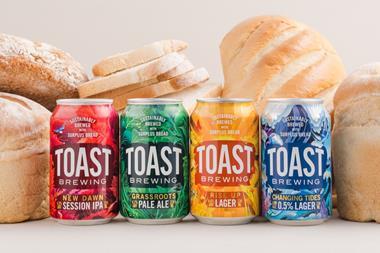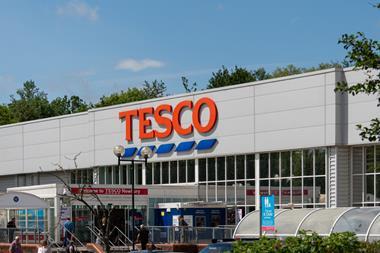The food industry is so preoccupied with factory gate pricing, it is easy to forget other issues could shunt road distribution on to the hard shoulder.
Getting from A to B isn’t easy. There are already numerous pressures on hauliers, including severe driver shortages and overcrowded roads. And, next month, the contentious congestion charge - denoted by its symbol - hits the capital. On top of that, the government is pressurising companies to legislate for cleaner vehicles, insurance premiums are set to rise, driver hours are being curtailed, and extreme weather conditions along with motorway closures are making journey times harder to predict.
Retailers are taking the driving seat in backhauling and factory gate pricing, and with home shopping growing and retail space increasing, they will have even more vehicles on the road.
According to IGD, most of the major retailers have already increased their vehicle fleets - by 20% over the last year in the case of Asda, M&S, Nisa-Today’s and Tesco.
The government admits that traffic congestion could increase by up to a fifth by the end of the decade. It recently unveiled a huge road-widening programme as part of a £5.5bn plan to improve transport.
The Freight Transport Association approves. But chief executive Richard Turner says congestion is the most serious issue for the industry in terms of cost. He wants more action in three areas: improving key points on troubled roads, such as roundabouts, clearing accidents more quickly, and getting better information about traffic jams.
Says Turner: “The food industry has the smartest logistics in the UK and it works well when it can rely on a good road network. You can reduce the inventory, do backhauling and factory gate pricing, but if a lorry gets stuck on the road, it is all undermined. Should the industry go on assuming that the roads are reliable? The only party that can answer that is the government. It would be a sad admission if they had to plan for an unreliable network.”
The authorities are attempting to address this with congestion charges - to which many retailers and wholesalers have already fiercely objected. And no wonder. A licence costs £5 a day with tough penalties for non-compliance, and it is estimated it could cost the industry £60m a year.
Turner labels the London charge a farce. “Lorries aren’t going into London for fun. There’s no question more people are wanting to access towns and cities, but it is not fair for vehicles like lorries which have no choice but to come into the capital.”
However, many other cities look set to follow suit, with Durham on board and Edinburgh already signed up for 2007. Lorries can’t even avoid congestion by delivering at off-peak hours because of strict rules governing night-time deliveries.
But for many operators, getting the drivers into their cabs in the first place is proving a bigger headache. There is already a shortage of about 45,000 drivers in the UK, a figure expected to grow 17% by 2010.
The haulage industry used to be populated by ex-servicemen, but that market has dried up, and some firms have been forced to bring drivers in from Eastern Europe to fill cabs. Somerfield brings Scottish drivers down south to cope with peak periods.
Says Turner: “I don’t know of any lorry that is not moving because there is no driver. But shortages mean the industry is using drivers they would rather not use, and paying for agencies to supply drivers.”
He believes the industry’s profile needs to be raised to encourage more young people to become drivers, but admits: “They can sometimes earn more money fitting satellite dishes.”
Added to this, drivers will soon be affected by the European Working Time Directive which will mean those who do more than just drive, such as checking security and unloading, can only work a 48 hour week.
Says Turner: “They normally work far more - about 55 hours on average - and the pressure will be on operators to find ways of organising drivers’ time which might mean different shift patterns or hiring extra drivers.”
The directive does not take effect for a year or so, but is predicted to add 17% to transport costs. This is worrying Somerfield logistics director Martin Oakes, who agrees it will increase costs.
“Twenty years ago we had as few as possible depots covering a big area, but in the future we might have to have more depots with more drivers so they will be able to get to them quicker.”
But more drivers means more lorries - which means more congestion. And it doesn’t end there. Overall, HGV operating costs are increasing at an annual rate of 6%, twice the rate of inflation.
UK hauliers now pay a pump price of more than £700 (excluding VAT) to fill a 1,000 litre tank compared with £425 in France and just £331 in Portugal.
And although there has not been a repeat of the fuel strikes two years ago, it is an issue that still irks many hauliers. The FTA reckons this, plus excessive vehicle tax, is crippling UK companies.
IGD supply chain development director Peter Davey says firms are pushing for transport optimisation to counteract these problems and cut costs. He reckons factory gate pricing and backhauling help, but big moves have been made by simple improvements such as stacking pallets higher and using better sized pallets to fit on more crates.
Particularly pertinent when, typically, only one third of vehicle journeys run empty. KPI’s 2002 transport survey in the UK food sector found that, on average, 70% of vehicles’ deck areas were utilised on laden trips, while about 20% of vehicle kilometres were run empty, and trailers were idle for 28% of the typical day. It also found 14.3% of the journey legs were subject to an unscheduled delay, 29% of which were mainly due to traffic congestion.
Dave Fawcett, business development director at Wincanton, says companies are now looking to work together to combat the pressure. “Food retailers are really proactive at the moment. If they are going half empty somewhere, they are working with other retailers to fill the load. Somerfield, for example, works with Argos in the south west.”
Fawcett says this has reduced the number of lorries standing idle at distribution centres.
Safeway supply operations director Mark Aylwin is enthusiastic about collaboration, and says: “We are very keen to talk to suppliers to see where we can get synergies and speed up the supply chain.”
He says most benefit is coming from looking at a better pallet and trailer fill.
In a bid to combat delays, the chain uses computer software to alert stores when a driver is approaching so they are ready to accept goods. It expects to see a 4% fall in the number of kilometres travelled, and aims to get drivers to work more efficiently.
But Turner says retailers need more reliable information, and hopes the government’s traffic information centre in the Midlands, set to open in 2004, will help by passing on regular updates into logistics firms’ systems. The FTA is also working on a system which can predict journey times based on different road conditions. It should be ready by the middle of the year.
But the IGD’s Davey admits there is still a lot of inefficiency in
the industry and thinks driver shortages will get a lot worse. But he is not completely pessimistic.
“With their big fleets, retailers are fairly well placed to deal with it and have critical mass to buy satellite navigation systems and route fleets the most effective way possible.
“Retailers are an effective lobby - they have a powerful argument to liaise with government.”
And it may soon come to that. After all, how long before inflationary pressures on transport costs end up increasing food prices? That’s something most supermarket chains would fight to resist.
But Somerfield’s Oakes says there is no guarantee this won’t happen. “As an industry we have managed to avoid it until now.
“But I don’t know how long that can continue.”
Getting from A to B isn’t easy. There are already numerous pressures on hauliers, including severe driver shortages and overcrowded roads. And, next month, the contentious congestion charge - denoted by its symbol - hits the capital. On top of that, the government is pressurising companies to legislate for cleaner vehicles, insurance premiums are set to rise, driver hours are being curtailed, and extreme weather conditions along with motorway closures are making journey times harder to predict.
Retailers are taking the driving seat in backhauling and factory gate pricing, and with home shopping growing and retail space increasing, they will have even more vehicles on the road.
According to IGD, most of the major retailers have already increased their vehicle fleets - by 20% over the last year in the case of Asda, M&S, Nisa-Today’s and Tesco.
The government admits that traffic congestion could increase by up to a fifth by the end of the decade. It recently unveiled a huge road-widening programme as part of a £5.5bn plan to improve transport.
The Freight Transport Association approves. But chief executive Richard Turner says congestion is the most serious issue for the industry in terms of cost. He wants more action in three areas: improving key points on troubled roads, such as roundabouts, clearing accidents more quickly, and getting better information about traffic jams.
Says Turner: “The food industry has the smartest logistics in the UK and it works well when it can rely on a good road network. You can reduce the inventory, do backhauling and factory gate pricing, but if a lorry gets stuck on the road, it is all undermined. Should the industry go on assuming that the roads are reliable? The only party that can answer that is the government. It would be a sad admission if they had to plan for an unreliable network.”
The authorities are attempting to address this with congestion charges - to which many retailers and wholesalers have already fiercely objected. And no wonder. A licence costs £5 a day with tough penalties for non-compliance, and it is estimated it could cost the industry £60m a year.
Turner labels the London charge a farce. “Lorries aren’t going into London for fun. There’s no question more people are wanting to access towns and cities, but it is not fair for vehicles like lorries which have no choice but to come into the capital.”
However, many other cities look set to follow suit, with Durham on board and Edinburgh already signed up for 2007. Lorries can’t even avoid congestion by delivering at off-peak hours because of strict rules governing night-time deliveries.
But for many operators, getting the drivers into their cabs in the first place is proving a bigger headache. There is already a shortage of about 45,000 drivers in the UK, a figure expected to grow 17% by 2010.
The haulage industry used to be populated by ex-servicemen, but that market has dried up, and some firms have been forced to bring drivers in from Eastern Europe to fill cabs. Somerfield brings Scottish drivers down south to cope with peak periods.
Says Turner: “I don’t know of any lorry that is not moving because there is no driver. But shortages mean the industry is using drivers they would rather not use, and paying for agencies to supply drivers.”
He believes the industry’s profile needs to be raised to encourage more young people to become drivers, but admits: “They can sometimes earn more money fitting satellite dishes.”
Added to this, drivers will soon be affected by the European Working Time Directive which will mean those who do more than just drive, such as checking security and unloading, can only work a 48 hour week.
Says Turner: “They normally work far more - about 55 hours on average - and the pressure will be on operators to find ways of organising drivers’ time which might mean different shift patterns or hiring extra drivers.”
The directive does not take effect for a year or so, but is predicted to add 17% to transport costs. This is worrying Somerfield logistics director Martin Oakes, who agrees it will increase costs.
“Twenty years ago we had as few as possible depots covering a big area, but in the future we might have to have more depots with more drivers so they will be able to get to them quicker.”
But more drivers means more lorries - which means more congestion. And it doesn’t end there. Overall, HGV operating costs are increasing at an annual rate of 6%, twice the rate of inflation.
UK hauliers now pay a pump price of more than £700 (excluding VAT) to fill a 1,000 litre tank compared with £425 in France and just £331 in Portugal.
And although there has not been a repeat of the fuel strikes two years ago, it is an issue that still irks many hauliers. The FTA reckons this, plus excessive vehicle tax, is crippling UK companies.
IGD supply chain development director Peter Davey says firms are pushing for transport optimisation to counteract these problems and cut costs. He reckons factory gate pricing and backhauling help, but big moves have been made by simple improvements such as stacking pallets higher and using better sized pallets to fit on more crates.
Particularly pertinent when, typically, only one third of vehicle journeys run empty. KPI’s 2002 transport survey in the UK food sector found that, on average, 70% of vehicles’ deck areas were utilised on laden trips, while about 20% of vehicle kilometres were run empty, and trailers were idle for 28% of the typical day. It also found 14.3% of the journey legs were subject to an unscheduled delay, 29% of which were mainly due to traffic congestion.
Dave Fawcett, business development director at Wincanton, says companies are now looking to work together to combat the pressure. “Food retailers are really proactive at the moment. If they are going half empty somewhere, they are working with other retailers to fill the load. Somerfield, for example, works with Argos in the south west.”
Fawcett says this has reduced the number of lorries standing idle at distribution centres.
Safeway supply operations director Mark Aylwin is enthusiastic about collaboration, and says: “We are very keen to talk to suppliers to see where we can get synergies and speed up the supply chain.”
He says most benefit is coming from looking at a better pallet and trailer fill.
In a bid to combat delays, the chain uses computer software to alert stores when a driver is approaching so they are ready to accept goods. It expects to see a 4% fall in the number of kilometres travelled, and aims to get drivers to work more efficiently.
But Turner says retailers need more reliable information, and hopes the government’s traffic information centre in the Midlands, set to open in 2004, will help by passing on regular updates into logistics firms’ systems. The FTA is also working on a system which can predict journey times based on different road conditions. It should be ready by the middle of the year.
But the IGD’s Davey admits there is still a lot of inefficiency in
the industry and thinks driver shortages will get a lot worse. But he is not completely pessimistic.
“With their big fleets, retailers are fairly well placed to deal with it and have critical mass to buy satellite navigation systems and route fleets the most effective way possible.
“Retailers are an effective lobby - they have a powerful argument to liaise with government.”
And it may soon come to that. After all, how long before inflationary pressures on transport costs end up increasing food prices? That’s something most supermarket chains would fight to resist.
But Somerfield’s Oakes says there is no guarantee this won’t happen. “As an industry we have managed to avoid it until now.
“But I don’t know how long that can continue.”














No comments yet